6.4 Creativity and Passion
Learning Objectives
- Describe how creativity relates to vision.
- Determine how passion relates to vision.
Creativity and passion are of particular relevance to mission and vision statements. A simple definition of creativity is the power or ability to invent. We sometimes think of creativity as being a purely artistic attribute, but creativity in business is the essence of innovation and progress. Passion at least in the context we invoke here, refers to an intense, driving, or overmastering feeling or conviction. Passion is also associated with intense emotion compelling action. We will focus mostly on the relationship between creativity, passion, and vision in this section because organizational visions are intended to create uneasiness with the status quo and help inform and motivate key stakeholders to move the organization forward. This means that a vision statement should reflect and communicate something that is relatively novel and unique, and such novelty and uniqueness are the products of creativity and passion.
Creativity and passion can, and probably should, also influence the organization’s mission. In many ways, the linkages might be clearest between creativity and vision statements and passion and mission statements because the latter is an expression of the organization’s values and deeply held beliefs. Similarly, while we will discuss creativity and passion separately in this section, your intuition and experience surely tell you that creativity eventually involves emotion, to be creative, you have to care about—be passionate about—what you’re doing.
Creativity and Vision
Work by DeGraf and Lawrence, suggest a finer-grained view into the characteristics and types of creativity (DeGraf & Lawrence, 2002). They argued that creativity “types” could be clustered based on some combination of flexibility versus control and internal versus external orientation. For the leader, their typology is especially useful as it suggests ways to manage creativity, as in simply hiring creative individuals. As summarized in the figure, their research suggests that there are four types of creativity: (1) investment (external orientation with high control), (2) imagination (external orientation with flexibility emphasis), (3) improvement (internal orientation with high control), and (4) incubation (internal orientation with flexibility emphasis).
The first type of creativity, investment, is associated with speed—being first and being fast. It is also a form of creativity fostered from the desire to be highly competitive. The second type of creativity, imagination, is the form that most of us think of first. This type of creativity is characterized by new ideas and breakthroughs: Apple’s stylish design of Macintosh computers and then game-changing breakthroughs with its iPod and iPhone. Oftentimes, we can tie this type of creativity to the drive or genius of a single individual, such as Apple’s Steve Jobs.

Where big ideas come from the imagination quadrant, improvement is a type of creativity that involves making an existing idea better. Two great examples of this are McDonald’s and Toyota. Ray Kroc, McDonald’s founder, had the idea of creating quality and cooking standards for preparing tasty burgers and fries. While there were many other burger joints around at the time (the 1950s), Kroc’s unique process-oriented approach gave McDonald’s a big advantage. Similarly, Toyota has used the refinement of its auto-making and auto-assembly processes (called the Toyota Business System) to be one of the largest and most successful, high-quality car makers in the world.
Finally, the fourth area of creativity is incubation. Incubation is a very deliberate approach that concerns a vision of sustainability—that is, leaving a legacy. This type of creativity is more complex because it involves teamwork, empowerment, and collective action. In their chapter on problem solving, David Whetten and Kim Cameron provide Gandhi as an example of incubation creativity:
While no one of these four types of creativity is best, they have some contradictory or conflicting characteristics. For example, imagination and improvement emphasize different approaches to creativity. The size of the new idea, for instance, is typically much bigger with imagination (i.e., revolutionary solutions) than with improvement (i.e., incremental solutions). Investment and incubation also are very different—investment is relatively fast, and the other relatively slow (i.e., incubation emphasizes deliberation and development).
Passion and Vision

Passion as we invoke the term in this chapter, refers to intense, driving, or overmastering feeling or conviction. Passion is also associated with intense emotion compelling action. Passion is relevant to vision in at least two ways: (1) Passion about an idea as inspiration of the vision and vision statement and (2) shared passion among organizational members about the importance of the vision.
Passion About the Vision
Passion doesn’t just have benefits for the individual entrepreneur or leader when formulating a vision statement, it can help the whole business thrive. While there is little academic research on the relationship between passion and vision, studies suggest that fostering engagement, a concept related to passion, in employees has a significant effect on the corporate bottom line. Gallup, for instance, has been on the forefront of measuring the effect of what it calls employee engagement. Employee engagement is a concept that is generally viewed as managing discretionary effort; that is, when employees have choices, they will act in a way that furthers their organization’s interests.
Engaged employees are those who are performing at the top of their abilities and happy about it. According to Gallup research 15% of employees worldwide and 35% in the U.S. are classified as engaged.(Gallup, n.d.) Consciously creating an environment where passion is both encouraged and actively developed can yield an enormous competitive advantage. That environment starts at the top through the development and active communication of mission and vision.
Exercises
- What is creativity?
- Why is creativity relevant to vision and vision statements?
- What is passion?
- Why is passion relevant to vision and vision statements?
- What is the relationship between passion and engagement?
Key Takeaways
“Creativity and Passion” in Principles of Management by University of Minnesota is licensed under a Creative Commons Attribution-NonCommercial-ShareAlike 4.0 International License, except where otherwise noted.

